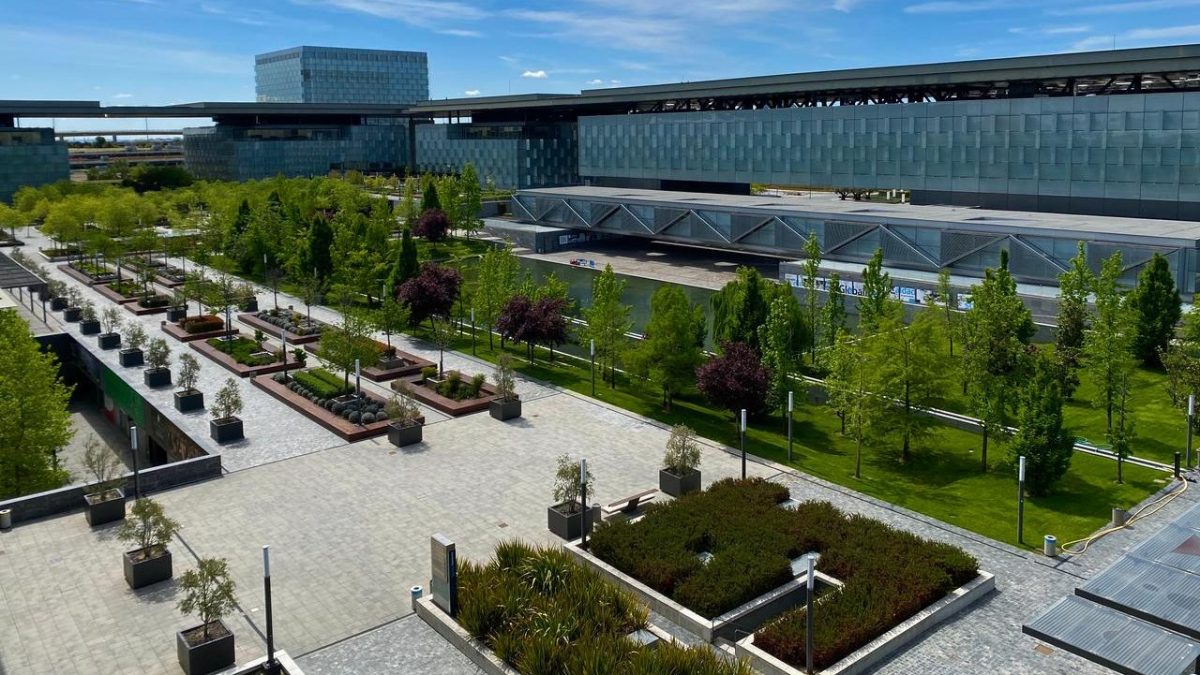Some of us are very lucky, we work at Telefónica, in Madrid and in a privileged location. We start with Plaza Norte:
In all the visitor parking areas, there are rows of trees that turn out to be lime trees (Tilia cordata) and between them flowering cherry laurel bushes (Prunus laurocerasus).
On entering the North square we are greeted by birch trees (Betula alba). We go up the stairs towards the North 3 building, in the area on the left and next to the cafeteria we can find:
Japanese Maple (Acer palmatum), Bald Cypress (Taxodium distichum) and Oak (Quercus spp). Among them we can see Acanthus (Acanthus mollis), Salvia (Salvia officinalis) and Fern. We retrace our steps and leaving a beautiful Birch (Betula alba) in the bicycle parking area, we go up the ramp on the way to the North Building 1. We can see on the right eight specimens of Bald Cypress (Taxodium distichum). The photo in this area shows a male Mallard (Anas platyrhynchos) resting.
We continue walking towards the back of the North 2 building and we come across an open area on the right where we can see different species: Birch (Betula alba), Teucrium (Teucriun fruticans), Oleander (Nerium oleander), Wisteria (Wisteria sinensis), Durillo (Viburnum tinus), Common Iris (Iris germánica), Agapanthus (Agapanthus praecox), Gaura (Gaura lindheimeri), Rose bush (Rosa spp.), Mahon chamomile (Santolina Chamaecyparissus), American creeping juniper (Juniperus horizontalis) and Rosemary (Rosmarinus officinalis).
If we continue walking we reach the area known as Jardín de los Caños Norte.
As we have already said in the East square promenade, in the information on the Telefónica District landscaping project we can read that this beautiful area “recovers the water treatment used in the Hispano-Arabic gardens” as this is where the second of the water channels leading to the central pond originates. The distribution of the terraced garden is the same and mixes the same species from humid environments: Iron tree (Parrotia pérsica) and Japanese maple (Acer palmatum) contrasting in texture and colour.
On the next lower terrace we find Palmito (Chamaerops humilis) and lastly, between the spouts, areas of Dwarf Bamboo (Pleioblastus spp). Directly opposite, at the back of the North 2 building, there is an area of Sacred Bamboo (Nandina domestica) and Jupiter Tree (Lagerstroemia indica).
Continuing along the path we head towards the North 3 building. On its sunniest side and within a few metres we can see: Hackberry (Celtis australis), Strawberry tree (Arbutus unedo), Common iris (Iris germanica), Olivilla (Teucrium fruticans), Durillo (Viburnum tinus), Rosemary (Rosmarinus officinalis), Gaura (Oenothera lindheimeri) Ivy (Hedera helix), Photinia “Red Robin” (Photinia x fraseri), Sharp honeysuckle (Lonicera nitida).
To finish this walk we continue along the edge of the North 3 building to enter the area known as the North Sandpit. Here we can find beautiful specimens of strawberry tree (Arbutus unedo) and olive tree (Olea europea). We can also see specimens of Olivilla (Phyllirea angustifolia), Ivy (Hedera helix) and New Zealand Flax (Phormium tenax) just to the left as we go down the stairs leading to the metro stop.
Don’t miss the other walks through the Plazas de Distrito to get to know their biodiversity.
